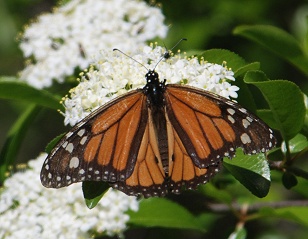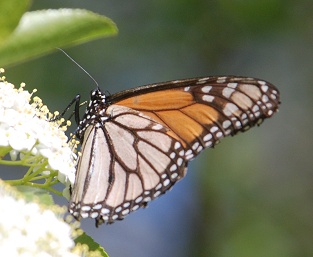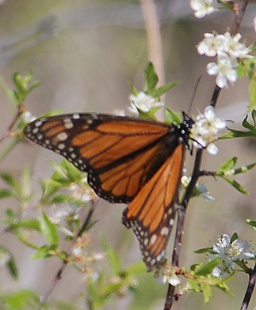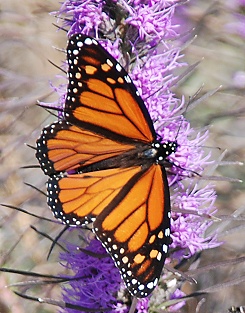Monarchs come through central Texas in both the spring and fall migrations. In spring, they particularly need wild milkweeds on which to lay eggs, but they also need flowers that provide nectar, in case they must fly farther to find the milkweeds (and this year, that’s important. Because of drought, the milkweed abundance is way down on our place.)
I usually see monarchs mating while perched on Ashe junipers–as wind protection–and nectaring on whatever’s blooming. Some years, they have a choice. This year, because of the drought, not much choice. The reliable woody shrubs bloom even when the flowering forbs are scarce. Rusty blackhaw viburnum and wild plum (both the Mexican plum and the thicketing plum) provided monarch feeding stations this year.

This particular viburnum overhangs the creekbed (now dry) and is at least twenty feet tall. Sunday it was covered with white flower clusters. Since we’ve owned the place, excluding livestock from the creek woods has allowed the growth of new viburnums, so in another ten to twenty years, we should have a lot of flowering shrubs–and some very happy monarchs.

Thicketing plum used to grow along many of the fencerows in this area, and even on some lots in town, but was eradicated as a “pest” or “messy” despite the fragrance of its flowers. Thicketing plums are not individually long-lived, and clumps change in size with rainfall and sun. But they’re an essential resource for many butterfly and moth species here…blues, hairstreaks, Red Admirals, Common Buckeyes, Variegated Fritillaries–all will nectar on thicketing plum (and on Mexican plum, of course.)

Thicketing plum flowers are tiny, but they hold enough nectar to keep a monarch intent on taking a sip of every one.
Everyone knows that monarchs need milkweeds…but they also need other nectar sources and shelter from strong winds and storms, both of which we have in spring. For those who live in areas where wild milkweeds and wild plums (or any kind of virburnum) do well, consider offering the monarch these proven favorites.
Monarchs also need nectar sources in the fall; around here, they come to frostweed, Maximilian sunflowers, and gayfeather (liatris.) A fresh fall monarch tanking up for that last dash to Mexico is stunning against the white of frostweed, the bright yellow of the sunflower, or the strong magenta of the gayfeather.

Comment by Marjorie Procter-Smith — April 2, 2009 @ 1:48 pm
I’ve seen quite a few monarchs in the past few weeks, mostly in the air. We normally have lots of milkweeds (several kinds), but they are down here as well. I have not yet seen them nectaring, though we do have some plums in the woods, they seem mostly to be done flowering.
By the way, your photographs are stunning. May I ask what camera you use? I have a digital (Sony Super Steady Shot) that does pretty well, but it’s not SLR, and I don’t get this kind of quality on close-up shots.
Comment by elizabeth — April 2, 2009 @ 4:50 pm
Our plums were late this year, because of the drought–so that extended the flowering time into the monarch migration. Usually they’re over by then.
Thanks for your kind words about the photographs. I use a Nikon D80 with a Tamron 28-300mm zoom lens most of the time. It’s the handiest “walking around” lens for my purposes, as it lets me get in close like a moderate macro, but gives me the 300 reach for more distant shots.
For birds, if I’m set up at one of our two wildlife guzzlers, I switch to an old (bought used) 300mm Nikkor lens with a 1.4 Tamron teleconverter. It’s way too heavy to hand-hold, though, so I can use it only for subjects that are predictable in location. I have to have a monopod to help with the weight.
There are other excellent cameras, of course–we had Nikon 35mm SLRs and went to Nikon for digitals because some of the old lenses can be used. I had variable results with non-SLR digitals…we had a Sony Mavica with good glass, and another brand that never did look sharp. But besides more pixels, and (usually) better quality glass for cleaner images, what you get with the SLRs is faster response to the shutter (handy with the critter you’re trying to image moves around) and more choices. (Nonetheless, I shoot on automatic most of the time.)
Comment by Chuck — April 5, 2009 @ 9:51 pm
Sitting by the pool after dipping out the day’s accumulation of blow-in oak catkins, my partner and I saw about one monarch per 3 minutes fly by. They were all heading south, since that’s the way the wind was blowing at the time.
Is it correct that on the spring migration, several generations of individuals are born, travel, reproduce, and die, while the individuals that migrate in the fall travel great distances and overwinter before starting back north in the spring?
Comment by elizabeth — April 5, 2009 @ 10:07 pm
It’s my understanding that there are multiple generations in both directions. I photographed a freshly emerged monarch one fall, which would tend to corroborate that, but I’m not sure. I do know that there’s great concern among monarch experts about the lack of native “wild” milkweed along the entire migration route. This year, with the drought, we have hardly any milkweed showing yet. Usually by now our antelope-horns milkweed (Asclepias asperula) is all over the place and blooming as well as showing a lot of good leafy larval food. Not this year. The biggest one I’ve found, in an area normally thick with them, is a foot long with stunted leaves. It wouldn’t feed a single larva to pupation. The monarchs I’m seeing are mostly very worn individuals–nearly transparent–which is what we get in the spring a lot. Somewhere I have a photo of one on a yellow iris, and you can see the iris petals through the wing.
But yesterday I saw one that looked fresh–much brighter color.